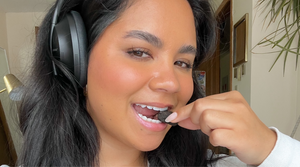Algae: Here’s why we’re so obsessed with this misfit plant
“You are what you eat” is a haunting truth in America.
- In a recent study form UCLA, scientists took a sample of hair and they found more than 70% of it's carbon (DNA) was made up of corn. -
If we are what we eat, Americans are essentially walking corn chips.
Just take a look at the three most prevalent ingredients in our diets: corn, soy and wheat. To keep up with the demand, the industry has found ways to mass produce these ingredients at the expense of stripping them of their nutritional complexity - all the good stuff! These nutritionally depleted foods have been modified and morphed into fats, sugars, additives, preservatives, capsules & fillers. Every single beverage, snack, or meal you have contains some variation of them. Even your vitamins!
Here at GEM, we're on a mission to re-nourish your body with whole plants that are not only incredibly nutrient-dense, but that are also tough to find in your everyday diet. And that's when we became obsessed with algae. Yes, we actually think algae can build a much sexier, complex & complete of who you are (more than corn chip at least). Hear us out:
The Misfit Plant 🌱
You may know algae as that green goo fondly referred to as pond scum. But don’t let its slimy exterior fool you. It is the superfood of the future and even a possible savior to humanity – even NASA, the UN, and Cargill think so.
Algae was the first plant life on earth 2.7 billion years ago. There is somewhere between 30,000 to 1,000,000 types of algae from microscopic diatoms to giant kelp. Scientists estimate that least 50% of the air we breathe comes from the oxygen generated by these plants. This amazing species is arguably even more powerful than the trees that surround us, existing in our oceans across 71% of the Earth’s surface.
...But how do you eat it? 🍴
Algae is considered a superfood because it contains almost every single nutrient. There are two main superstars of algae when it comes to food and our nutrition: spirulina & chlorella.
Spirulina:
- 50x more iron than spinach
- Packed with large amounts of calcium, niacin, potassium, B vitamins, antioxidants, and all essential amino acids
- Body can more easily absorb nutrients through spirulina than other protein-rich food like meat and soybeans
- 1g of Spirulina = 1kg of Fruits & Vegetables
Chlorella
- Contains over 40 nutrients including all B vitamins, vitamin C, zinc and many minerals
- Supports healthy hormonal function
- Promotes cardiovascular health
- Aids in the detoxification of our bodies (specifically heavy metals)
Astaxanthin
- Helps with physical and muscular endurance and recovery
- Helps protect the body from free radicals
- Contributes to good cardiovascular health
- Helps lower inflammation in your eyes
All the Things Algae Can Do 💪...
Food & nutrition is just one of the many things algae can do. It has also been studied, used, and researched for its potential in:
- Biofuels
- Plastics
- Animal & fish feed
- Fertilizers
- Sugar & oil replacements
- Cosmetics
- Medicinal products
- and of course in all things Gem :)
The Many Colors of Algae 🌈
🔴 Red Algae: Red algae are essential members of the coral reefs. Red algae are rare among the algae since they can contain calcium carbonate in their cell walls which make the plants hard and highly resistant to wear. Red algae are used in the treatment of urinary infections, cold sores, stomach disorders, asthma and to improve the immune system and reduce the level of cholesterol in the blood.
💙Blue-Green Algae: Blue-green algae is 70% vegetable protein and has higher levels of beta-carotene than broccoli. The one-two punch potency of blue-green algae is that it contains a high concentration of nutrients - over 65 vitamins, minerals and enzymes and the complete spectrum of eight essential amino acids and ten nonessential amino acids… and they are all easily absorbed by the body.
🏾 Brown Algae: Brown algae mainly lives in the tidal zones of temperate to polar seas, but some can be found in the deep ocean. Among the brown algae are the biggest and most complex of the algae; common forms include the free-floating sargassum weed and the giant kelp.
Nerding out on Algae 
1) Percent of oxygen produced by algae: 30%-50%
2) Milligrams of carrageenans, a red algae extract, the average American consumes daily, often in dairy products: 250
3) Maximum length, in feet, that kelp, the largest algae, can grow: 200
4) Times more productive algae is than traditional crops as a biofuel: 50
5) Number of Continental Airlines flight that, in November, was the first U.S. commercial passenger trip powered by algae biofuel: 1403
6) Years ago, after a mass extinction, that algae and bacteria consumed all of the sea’s oxygen, slowing the earth’s recovery: 250,000,000
7) Number of glowing algae that can be found in a gallon of water from Puerto Rico’s bioluminescent bays: 720,000
How is algae changing our world? 🌎
- Helps end deforestation because it can replace soy protein
- Most sustainable crop because it can grow anywhere on the planet (salt water, fresh water, polluted water – even space!) and double its volume in less than 6 hours
- Helps improve air quality + reduce greenhouse gas emissions due to its photosynthetic qualities. It converts CO2 to O2 and for higher productivity algae, it can be fed emissions from power plants or ethanol facilities
- Can be used to purify industrial wastewater and prevent harmful run off
- European Space Agency & NASA use it to produce oxygen in space
- UN announced at the World Food coherence that Spirulina is, “The most ideal food for mankind.” (We think for Womankind specifically)
Image by Daniel Poloha/Adobe Stock






